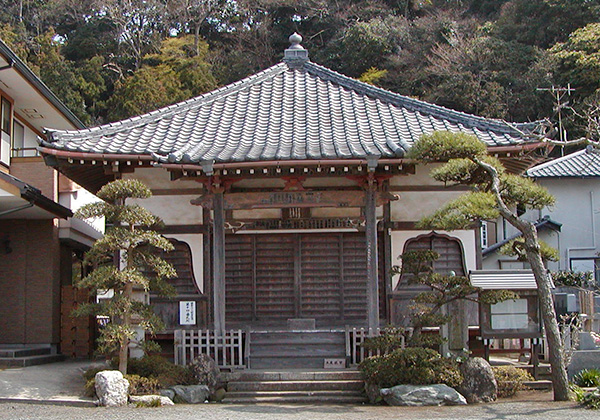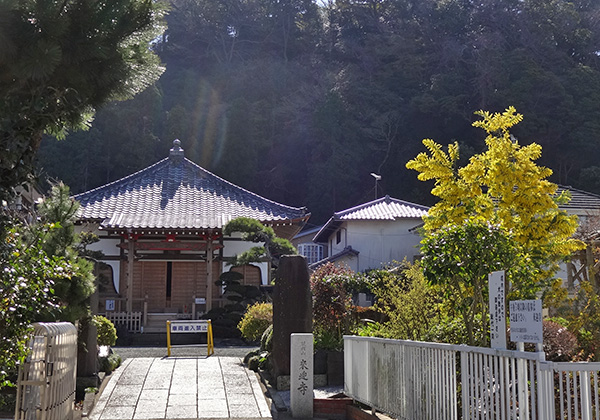Raikoji
| Official Name | Zuigazan Raikoji {Pronounced zooy-gah-zan rye-koh-gee} |
|---|---|
| Religious sect | Ji Sect, Buddhism |
| Founded | in 1194 by Yoritomo Minamoto {yoh-re-toh-moh me-nah-moh-toh} |
| Founding priest | On-a {on-ah} |
| Main object of worship | Statues of Amida {ah-me-dah} Trinity |
| Address | 9-19, Zaimokuza 2-chome, Kamakura, Kanagawa 248-0013 (show route from current location ) |
| Location | 1,100 meters south southeast of Kamakura Station |
| Time needed to get there | 20 minutes from Kamakura Station |
| Open | 9:30 - 16:30 |
| Phone number | 0467-22-4547 |
| Restrooms | Not available |
Historical Overview
The founder of the Temple, Yoritomo Minamoto {yoh-re-toh-moh me-nah-mo-toh} (1147-1199), is one of the most notable samurai warriors as the founder of the Kamakura Shogunate and the military dictator of Japan in the last decade of 12th century. But, he was not a ruler by nature. When young, he was exiled from Kyoto to a remote town in the Izu {e-zoo} Peninsula, 90 kilometers southwest of Tokyo, as a legitimate son of the chief of the Minamoto Clan defeated by the arch-rival Taira Clan. At age 33, he initiated the first battle at the foot of the Peninsula against the local warlords who belonged to the Taira.
Hearing Yoritomo rose up against the Taira, the Miura faction that dominated the Miura Peninsula area (hence the name) with its base castle at today's Yokosuka city and had long been allied with the Minamoto Clan rushed to the battleground to take part in the fight. Back at his castle, however, the Miura troops were attacked by one of the Taira group led by Shigetada Hatakeyama {she-geh-tah-dah hah-tah-keh-yah-mah} (1164-1205). Though Yoshiaki Miura {yo-she-ah-kee me-woo-rah} (1092-1180), the chief of the Miura faction, knew that there was no chance for him to win the imminent battle without his son Yoshizumi {yo-she-zoo-me} (1127-1200), he made Yoshizumi get away from the castle to join the Yoritomo troops. In addition, he was then too old (89) to fight. Staying at the castle, Yoshiakihad to fight the losing battle against the Hatakeyama and sacrificed his life. In the meantime, Yoshizumi showed remarkable services for Yoritomo.
Thanks to the Miura's contribution, Yoshiaki in particular, and their distinguished services, Yoritomo won at ensuing skirmishes against the local factions of the Taira, and eventually set up his military government in Kamakura in 1180 unifying Japan. Naturally, he gave important posts to the members of the Miura. In memory of and for the bliss of the departed Yoshiaki, Yoritomo ordered to construct a temple for him. It was called Nozoji {noh-zoh-gee} erected in 1194 as a Shingon sect.
The Miura's loyalty continued well into the Hojo Era. In 1200, they helped the Hojo win the battle against Kajiwara faction. At the time another battle broke out between the Hojo and the Wada factions led by Yoshimori Wada {yo-she-mo-re wah-dah} (1147-1213) in 1213, Yoshimura {yo-she-moo-rah} (?-1239), son of Yoshizumi, betrayed the Wada breaking his word and sided with the Hojos, despite the fact that they were cousins. As a result, the Wada faction was wiped out. On the occasion of the Third Shogun's assassination, Yoshimura even killed Kugyo {koo-gyo} (1200-1219), the assassin, again despite the fact that Yoshimura's wife had been a wet nurse of Kugyo.
Miura's Machiavellianism, however, did not last long. Next was their turn. With its growing influence, Yasumura {yah-soo-moo-rah} (?-1247), son of Yoshimura, and his brother approached a branch family of the Hojo to help them plot a conspiracy against the head Hojo family. The plot was soon laid bare, and Fifth Hojo Regent Tokiyori {toh-kee-yo-re} (1227-1263), with the help of the Adachi {ah-dah-chee} faction, launched an attack on the Miura residence in 1247. Roughly 500 samurai belonging to the Miura factions were forced to commit mass suicide at Yoritomo's Hokkedo hall, which was located near Tsurugaoka Hachimangu Shrine (but no longer exists). It is called Hochi Gassen {hoh-chee gas-sen} or the Battle of Hochi Years. Afterwards, the Hojo faction overthrew even the Adachi faction. Unrivaled by anyone else now, the Hojo succeeded in establishing the Hojo regime, which lasted for more than a century.
Though the Temple originally belonged to the Shingon Sect as noted earlier, a priest named On-a {on-ah} changed the denomination to Ji sect, and renamed Raikoji in later years.

Main Hall

The old structure used to stand on top of the hill behind today's hall. Toward the end of the Pacific War, American bombers began to attack mainland Japan. On March 10, 1945, for example, Tokyo was burned out by a major air raid and nearly one hundred thousand people were killed. Since the hall stood out and seemed to be an easy target for the fighter planes, the military authorities ordered the Temple to move the hall down to the present-day site. (Fortunately, Kamakura was never attacked thanks to the efforts made by Langdon Warner (1881-1955), a Harvard-graduate art critic who persuaded the American authorities as a member of the Roberts Commission not to bomb such old towns full of cultural assets like Kyoto, Nara and Kamakura.)
The main objects of worship are statues of Amida (Amitabha in Sanskrit) trinity, or the Amida statue in the center attended by Kan'non Bosatsu (Avalokitesvara in Skt.) to its left and Seishi Bosatsu {say-she boh-sah-tsu} (Mahasthama-prapta in Skt.) to its right. The Amida Trinity was believed to have been the guardian deities of Yoshiaki Miura.
Also enshrined in the hall is the statue of Sho-Kan'non (Arya-avalokitesvara in Skt.) , which is 14th of the Kamakura Thirty-Three Kan'non Pilgrimage and popularly known as Kosodate {ko-so-dah-teh} or Child-Nursing Kan'non. The Temple runs a kindergarten inside the temple grounds presumably because of this deity.
As to when and by whom those statues were fashioned are unknown.

